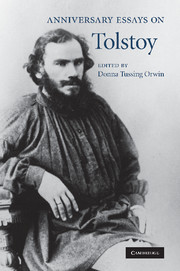Book contents
- Frontmatter
- Contents
- Acknowledgments
- List of contributors
- Introduction
- 1 Tolstoy and music
- 2 Sublime vision and self-derision: the aesthetics of death in Tolstoy
- 3 Tolstoy's peaceable kingdom
- 4 Leo Tolstoy: pacifist, patriot, and molodets
- 5 Leo Tolstoy's correspondence with Nikolai Strakhov: the dialogue on faith
- 6 The worm of doubt: Prince Andrei's death and Russian spiritual awakening of the 1860s
- 7 Tolstoy's spirituality
- 8 Tracking the English novel in Anna Karenina: who wrote the English novel that Anna reads?
- 9 Violence and the role of drama in the late Tolstoy: The Realm of Darkness
- 10 What men quote by: Tolstoy, wise sayings, and moral tales
- 11 The “proletarian lord”: Leo Tolstoy's image during the Russian revolutionary period
- Bibliography
- Index
1 - Tolstoy and music
Published online by Cambridge University Press: 03 May 2010
- Frontmatter
- Contents
- Acknowledgments
- List of contributors
- Introduction
- 1 Tolstoy and music
- 2 Sublime vision and self-derision: the aesthetics of death in Tolstoy
- 3 Tolstoy's peaceable kingdom
- 4 Leo Tolstoy: pacifist, patriot, and molodets
- 5 Leo Tolstoy's correspondence with Nikolai Strakhov: the dialogue on faith
- 6 The worm of doubt: Prince Andrei's death and Russian spiritual awakening of the 1860s
- 7 Tolstoy's spirituality
- 8 Tracking the English novel in Anna Karenina: who wrote the English novel that Anna reads?
- 9 Violence and the role of drama in the late Tolstoy: The Realm of Darkness
- 10 What men quote by: Tolstoy, wise sayings, and moral tales
- 11 The “proletarian lord”: Leo Tolstoy's image during the Russian revolutionary period
- Bibliography
- Index
Summary
Tolstoy's relations with music – the least mediated of the temporal arts, and thus for him the most potent – were reverent, wary, and on occasion punitive. He was fascinated by the force of music, just as he was by the force of sexuality, beauty, and war. By “force” Tolstoy did not mean violence or disruption, but the power to organize, suddenly and irresistibly, all our scattered actions and feelings into a coherent meaningful whole. Thus focused in its energies, the human organism would fear nothing, not even its own mortality. But since this heightened condition lent itself equally well to sublime insight and to irrational acts, it had to be carefully watched. Furthermore, music, being neither an instinct nor a force of nature but the product of creative human striving, obligated its practitioners to positive deeds as our more animal sides did not. The intensely receptive and aesthetically arousable Tolstoy worked hard at the piano as a young man, and he continued to revere music long after he had abjured war, sex, and beauty. Everything he wanted to accomplish through words happened faster and more purely through music.
These fundamentally Romantic priorities manifested themselves early. In a diary entry from November 1851, the 23-year-old Tolstoy charted the fine arts according to their ability to act on the imagination. The realm of visual art or painting is space, where we realize an image of nature. The realm of music is harmony and time, where we realize feelings.
- Type
- Chapter
- Information
- Anniversary Essays on Tolstoy , pp. 8 - 32Publisher: Cambridge University PressPrint publication year: 2010
- 2
- Cited by



